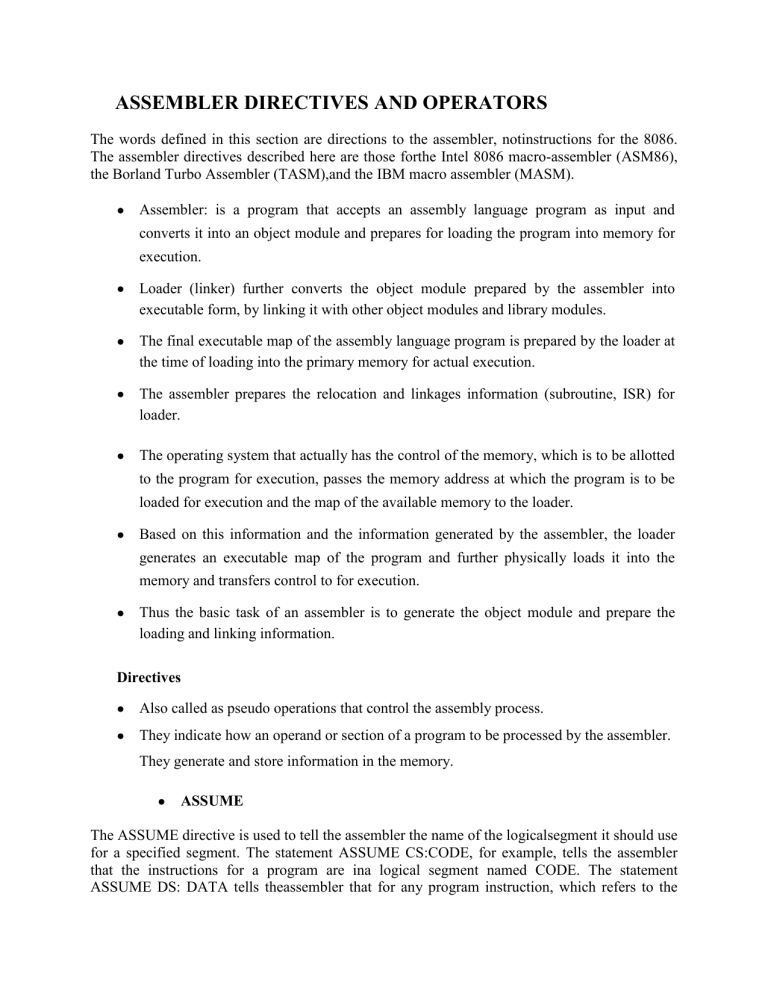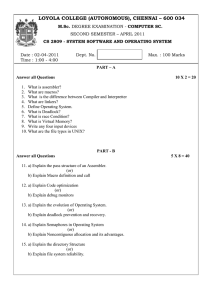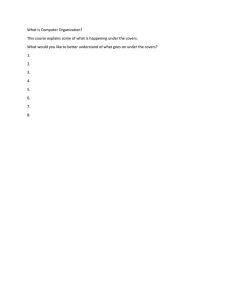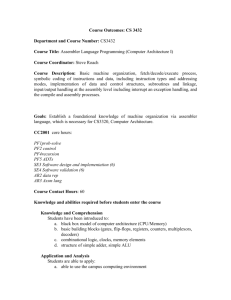
ASSEMBLER DIRECTIVES AND OPERATORS The words defined in this section are directions to the assembler, notinstructions for the 8086. The assembler directives described here are those forthe Intel 8086 macro-assembler (ASM86), the Borland Turbo Assembler (TASM),and the IBM macro assembler (MASM). Assembler: is a program that accepts an assembly language program as input and converts it into an object module and prepares for loading the program into memory for execution. Loader (linker) further converts the object module prepared by the assembler into executable form, by linking it with other object modules and library modules. The final executable map of the assembly language program is prepared by the loader at the time of loading into the primary memory for actual execution. The assembler prepares the relocation and linkages information (subroutine, ISR) for loader. The operating system that actually has the control of the memory, which is to be allotted to the program for execution, passes the memory address at which the program is to be loaded for execution and the map of the available memory to the loader. Based on this information and the information generated by the assembler, the loader generates an executable map of the program and further physically loads it into the memory and transfers control to for execution. Thus the basic task of an assembler is to generate the object module and prepare the loading and linking information. Directives Also called as pseudo operations that control the assembly process. They indicate how an operand or section of a program to be processed by the assembler. They generate and store information in the memory. ASSUME The ASSUME directive is used to tell the assembler the name of the logicalsegment it should use for a specified segment. The statement ASSUME CS:CODE, for example, tells the assembler that the instructions for a program are ina logical segment named CODE. The statement ASSUME DS: DATA tells theassembler that for any program instruction, which refers to the data segment, itshould use the logical segment called DATA. If, for example, the assembler readsthe statement MOV AX,[BX] after it reads this ASSUME, it will know that thememory location referred to by [BX] is in the logical segment DATA. We musttell the assembler what to assume for any segment we use in a program. If weuse a stack in our program, we must tell the assembler the name of the logicalsegment we have set up as a stack with a statement such as ASSUME SS:STACK_HERE. For a program with string Instructions which use DI, EQU: Equates a numeric, ASCII(American Standard Code for Information Interchange) or label to another label. Example Data SEGMENT Num1 EQU 50H Num2 EQU 66H Data ENDS Numeric value 50H and 66H are assigned to Num1 and Num2 ORG: Changes the starting offset address of the data in the data segment Example ORG 100H 100 data1 DB 10H it can be used for code too. PROC & ENDP: indicate the start and end of the procedure. They require a label to indicate the name of the procedure. NEAR: the procedure resides in the same code segment. (Local) FAR: resides at any location in the memory. Example Add PROC NEAR ADD AX,BX MOV CX,AX RET Add ENDP PROC directive stores the contents of the register in the stack. EXTRN, PUBLIC informs the assembler that the names of procedures and labels declared after this directive have been already defined in some other assembly language modules. DB define byte DW define word DD define double word DQ define 10 bytes Example Data1 DB 10H,11H,12H Data2 DW 1234H SEGMENT: statement to indicate the start of the program and its symbolic name. Example Name SEGMENT Variable_name DB ……. Variable_name DW ……. Name ENDS Data SEGMENT Data1 DB ……. Data2 DW ……. Data ENDS Code SEGMENT START: MOV AX,BX Example If you want to call a Factorial procedure of Module1 from Module2 it must be declared as PUBLIC in Module1. Example A sample for full segment definition Data SEGMENT Num1 DB 10H Num2 DB 20H Num3 EQU 30H Data ENDS ASSUME CS:Code,DS:Data Code SEGMENT START: MOV AX,Data MOV DS,AX MOV AX,Num1 MOV CX,Num2 ADD AX,CX Code ENDS Example A sample for small model . MODEL SMALL .Data Num1 DB 10H Num2 DB 20H Num3 EQU 30H . Code HERE:MOV AX,@Data MOV DS,AX MOV AX,Num1 MOV CX,Num2 ADD AX,CX Code ENDS Similarly the stack segment is also declared. For small models .DATA … … ENDS The ENDS directive indicates the end of the segment. Memory is reserved for use in the future by using a ? as an operand for DB DW or DD directive. The assembler sets aside a location and does not initialize it to any specific value(usually stores a zero). The DUP (duplicate) directive creates an array and stores a zero. Example Data1 DB 5 DUP(?) This reserves 5 bytes of memory for a array data1 and initializes each location with 05H ALIGN: memory array is stored in word boundaries. Example ALIGN 2 means storing from an even address The data XX is aligned to the even address -----------------------------------------------------------------------------------------------------



